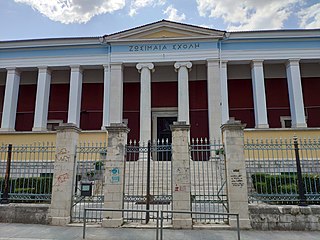
Esperanto is the most widely spoken constructed international auxiliary language. It was created by Polish ophthalmologist L. L. Zamenhof in 1887, when he published a book detailing the language, Unua Libro, under the pseudonym "Dr. Esperanto". The word esperanto translates into English as "one who hopes".
L. L. Zamenhof developed Esperanto in the 1870s and 80s and published the first publication about it, Unua Libro, in 1887. The number of Esperanto speakers has grown gradually since then, although it has not had much support from governments and international organizations and has sometimes been outlawed or otherwise suppressed.

Dr. Esperanto's International Language, commonly referred to as Unua Libro, is an 1887 book by L. L. Zamenhof, in which the author first introduced and described the constructed language Esperanto. First published in Russian on July 26 [O.S. July 14] 1887, the publication of Unua Libro marks the formal beginning of the Esperanto movement.

The Universal Esperanto Association, also known as the World Esperanto Association, is the largest international organization of Esperanto speakers, with 5501 individual members in 121 countries and 9215 through national associations and in official relations with the United Nations. In addition to individual members, 70 national Esperanto organizations are affiliated with UEA. Its current president is the professor Duncan Charters. The magazine Esperanto is the main organ used by UEA to inform its members about everything happening in the Esperanto community.

Land and Liberty was a Russian clandestine revolutionary organization of Narodniki in the 1870s.
The Manifesto of Prague is a historic document that establishes a set of seven widely shared principles of the Esperanto movement. It was drafted at the 1996 World Esperanto Congress in Prague by officials from the United Nations Educational, Scientific and Cultural Organization (UNESCO) and those attending the congress. The document emphasizes democratic communication, language rights, preservation of language diversity, and effective language education.

Esperanto-USA (E-USA) is the largest organization for speakers and supporters of Esperanto in the United States. It was founded in 1952 as the Esperanto League for North America (ELNA) in Sacramento, California. Headquartered in Emeryville, California, Esperanto-USA is a 501(c)3 nonprofit organization and the U.S. affiliate of the Universal Esperanto Association. Phil Dorcas is President of E-USA, and Ben Speakmon is Vice-President.

The phrase Catholic youth work covers a wide range of activities carried out with young people, usually in the name of the Catholic Church and with the intention of imparting the Catholic faith to them and inviting them to practice and live out the faith in their lives. Activities in the field range from small scale youth groups attached to parishes or Catholic schools, to large international gatherings, such as World Youth Day. It is a field which has evolved much over recent decades, especially in comparison to more formal methods of education or catechesis within the church. Nearly all dioceses and a great deal of parishes have some form of youth provision running, although a great deal of areas particularly in the developed world are finding youth work both more difficult and rare as the numbers of young people regularly practicing the Catholic faith continue to decline. In contrast, though, the new and exciting developments of recent decades and particularly the influence of the new movements within the Church are ensuring that youth work continues to be an active and fruitful field.

Gavriil Vasilyevich Baranovsky was a Russian architect, civil engineer, art historian and publisher, who worked primarily in Saint Petersburg for the Elisseeff family, but also practiced in Moscow and produced the first town plan for Murmansk.

Gleb Ivanovich Uspensky, was a Russian Empire writer, and a prominent figure of the Narodnik movement.

Dua Libro de l' Lingvo Internacia, usually referred to simply as Dua Libro, is an 1888 book by L. L. Zamenhof. It is the second book in which Zamenhof wrote about the constructed language Esperanto, following Unua Libro in 1887, and the first book to be written entirely in the language.

Max Josef Metzger was a Catholic priest and leading German pacifist who was executed by the Nazis during World War II.

Hector Hodler was a Swiss Esperantist who had a strong influence on the early Esperanto movement.

The Zosimaia School of Ioannina has been one of the most significant Greek middle-level educational institutions during the last period of Ottoman rule in the region (1828–1913). The Zosimaia was founded at 1828 through the personal expense of the Zosimas brothers, and is still functioning as a high school under the regulations of the Greek Ministry of Education.

E@I ("Education@Internet") is an international youth non-profit organization that hosts educational projects and meetings to support intercultural learning and the usage of languages and internet technologies.

Leopold Einstein was a Jewish teacher, vendor, and writer. He was one of the early proponents of Esperanto.
A hromada was one of a network of secret societies of Ukrainian intelligentsia that appeared soon after the Crimean War. The societies laid a groundwork for appearance of the Ukrainian political elite and national political movement. The Ukrainian national and anti-oppressive movement intensified with the January Uprising and issuing of the Valuev Circular. Many former members of the disbanded Brotherhood of Saints Cyril and Methodius.

La Esperantisto was the first Esperanto periodical, published from 1889 to 1895. L. L. Zamenhof started it in order to provide reading material for the then-nascent Esperanto community.















